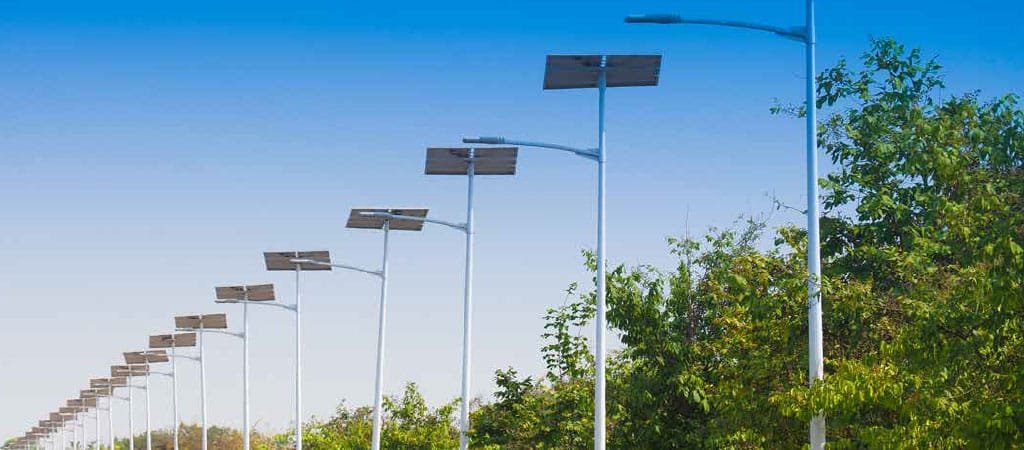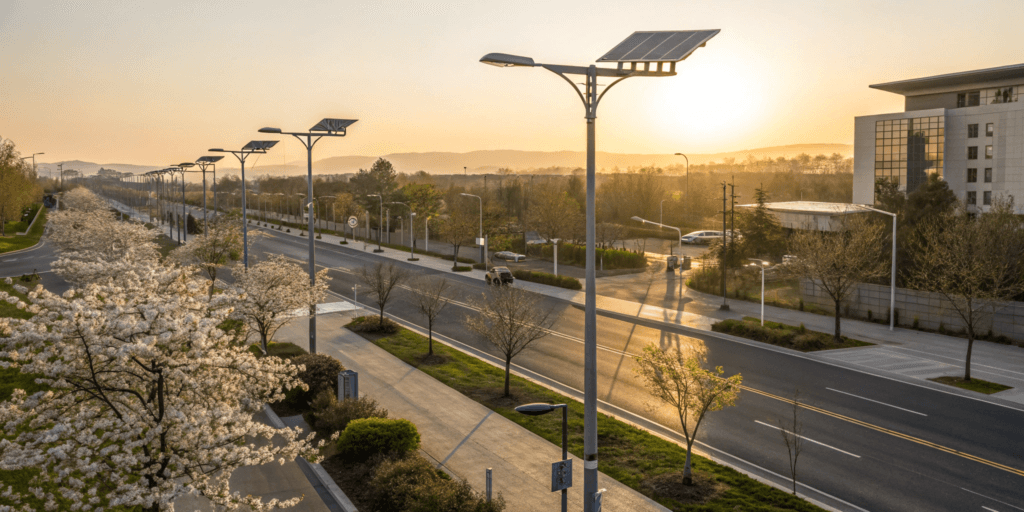LED street lights have rapidly replaced traditional street lighting solutions across Africa, offering unmatched efficiency, durability, and environmental benefits. As someone who has worked in project procurement and installation for over 15 years, I’ve seen firsthand how LED technology has transformed urban and rural lighting projects. This guide walks you through everything you need to know—from how they work to how to choose, install, and maintain them—so you can make an informed investment.
1. Introduction to LED Street Light
Over the past decade, LED street light systems have become the standard for public lighting projects in many African cities and rural towns. Governments, NGOs, and private contractors are increasingly specifying LEDs in tenders, largely because of their ability to reduce energy bills, extend operational lifespans, and improve nighttime safety.
From my own experience managing solar and grid-powered lighting projects in East Africa, I can say the shift was not just about saving money—it was about long-term reliability in environments where maintenance resources are limited.
1.1 What is an LED Street Light?
An LED street light uses Light Emitting Diodes (LEDs) as its light source instead of traditional sodium vapor, halogen, or metal halide lamps. LEDs produce light by passing current through a semiconductor, which emits photons (light). The process is far more efficient than heating filaments or using gas discharge.
1.2 Why Are LED Street Lights Increasingly Popular?
- Lower operating costs over time
- Better lighting performance with higher lumen output per watt
- Longer service life, often exceeding 50,000 hours
- Customizable light color for safety and aesthetics
- Compatibility with solar power systems, critical for off-grid communities
2. Key Benefits of LED Street Light
From a procurement and operational perspective, the advantages are compelling. Here’s why most of the tenders I see today favor LEDs over traditional fixtures.

2.1 Energy Efficiency of LED Street Light
An LED street light converts up to 80–90% of electrical energy into visible light. That’s significantly higher than the 30–40% efficiency of high-pressure sodium lamps. In projects I’ve overseen, switching to LEDs has cut energy consumption by 50% or more.
2.2 Cost Savings with LED Street Light
While the initial purchase price of an LED street light may be higher, the total cost of ownership is much lower because of:
- Reduced electricity bills
- Fewer replacements due to long lifespan
- Lower maintenance labor costs
One Kenyan municipality we worked with achieved a payback period of just 2.5 years after upgrading 1,200 fixtures.
2.3 Environmental Impact and Sustainability of LED Street Light
LED street lights are mercury-free and generate less CO₂ due to reduced energy demand. For rural electrification projects powered by solar, this makes them an environmentally responsible choice.
2.4 Enhanced Performance and Brightness of LED Street Light
Modern LEDs provide uniform light distribution with minimal glare, improving road safety. The color rendering index (CRI) of LEDs is much higher than sodium lamps, which means objects and road markings appear more natural and visible.
3. Common Drawbacks and Challenges of LED Street Light
Even with clear advantages, there are factors you need to consider before committing to a large-scale rollout.
3.1 Potential Issues in LED Street Light Technology
- Upfront cost remains higher than traditional lamps
- Quality varies widely between manufacturers—cheaper options may fail prematurely
- Poor heat dissipation design can reduce lifespan in hot climates
3.2 Maintenance Considerations for LED Street Light
While maintenance needs are lower, they aren’t zero. Dust accumulation on lenses, for example, can reduce brightness and must be cleaned periodically.
3.3 Durability and Lifespan of LED Street Light
Quality LED fixtures can last 50,000–100,000 hours. However, substandard units, often found in low-bid tenders, may fail in less than three years. This is why I always recommend verifying LM80 test reports and supplier track records.
4. How to Choose the Right LED Street Light

4.1 Factors to Consider When Selecting LED Street Light
- Lumen output suitable for road type and width
- Color temperature (e.g., 3000K for warm, 5000K for daylight white)
- Ingress protection (IP) rating for dust and water resistance
- Surge protection especially in areas with unstable grids
- Warranty length—anything less than 5 years should raise questions
4.2 Comparison: LED Street Light vs. Traditional Street Lighting
| Feature | LED Street Light | High Pressure Sodium (HPS) |
|---|---|---|
| Energy efficiency | 80–90% | 30–40% |
| Lifespan | 50,000–100,000 hrs | 12,000–24,000 hrs |
| Color rendering (CRI) | 70–90 | <25 |
| Maintenance frequency | Low | High |
| Environmental impact | No mercury, low CO₂ | Contains mercury |
4.3 Recommended Specifications for LED Street Light
For African urban roads:
- 100–150W LED fixture
- 5000–7000K color temperature
- IP65 or higher rating
- Integrated surge protection of at least 10kV
5. Installation and Maintenance of LED Street Light

5.1 Steps to Install LED Street Light
- Site survey for pole placement and height
- Wiring and power connection (grid or solar system)
- Mounting using appropriate brackets and hardware
- Angle adjustment for optimal light coverage
- Testing for uniformity and brightness
5.2 Maintenance Tips for LED Street Light
- Clean lenses and housings at least twice a year
- Inspect wiring for damage or corrosion
- Replace surge protection modules periodically
- Keep firmware updated for smart-controlled units
5.3 Safety and Compliance Guidelines for LED Street Light
Ensure all fixtures meet IEC and local safety standards. Use licensed electricians for installation to avoid compliance issues during project audits.
6. Cost Analysis for LED Street Light
6.1 Initial Investment and Long-term Savings from LED Street Light
In most projects I’ve handled, LEDs cost 20–40% more upfront than HPS lamps. However, they save 50–70% in energy costs and last 3–5 times longer.
6.2 Financial Incentives and Rebates for LED Street Light
Some African countries and donor-funded programs offer grants or tax incentives for municipalities adopting energy-efficient lighting. These can significantly shorten payback periods.
7. Environmental and Community Impact of LED Street Light

7.1 Reducing Carbon Footprint with LED Street Light
Switching a city’s 10,000 streetlights to LEDs can reduce CO₂ emissions by thousands of tons annually, equivalent to taking hundreds of cars off the road.
7.2 Improving Nighttime Visibility with LED Street Light
LEDs improve visibility, reduce crime rates, and make roads safer for drivers and pedestrians. In rural areas, they support community activities after sunset.
8. Frequently Asked Questions about LED Street Light
What is the expected lifespan of an LED street light?
Quality LEDs last 50,000–100,000 hours, which means 12–20 years at typical usage rates.
Are LED street lights safe for wildlife?
Choosing warmer color temperatures (3000K or lower) minimizes disruption to nocturnal animals.
Can LED street lights be controlled remotely?
Yes, many models now include smart control systems for dimming, scheduling, and fault detection.
9. Conclusion: Is LED Street Light the Right Choice for You?
If you are looking for a long-term, low-maintenance, and energy-efficient solution, the LED street light is hard to beat. My advice, based on years of project oversight, is to focus on quality over price—cheap fixtures often cost more in the long run due to premature failure and higher maintenance needs.
The technology is proven, the environmental benefits are clear, and the operational savings are measurable. For municipalities, contractors, and NGOs across Africa, now is the right time to make the switch.


